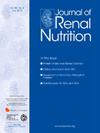慢性肾病患者的咸味感知能力受损导致钠摄入量增加:一项双中心横断面研究。
IF 3.2
3区 医学
Q2 NUTRITION & DIETETICS
引用次数: 0
摘要
目的:饮食限钠对慢性肾脏病(CKD)患者的预后非常重要。CKD 患者的咸度感知与钠摄入量之间的关系尚不明确,影响咸度的因素也不完全清楚。我们使用钠溶液进行了一种经济有效的咸度感知测试,评估了 CKD 患者的咸度感知,并评估了咸度感知、钠摄入量和影响因素之间的关联:从两家医疗中心招募未进行透析的慢性肾脏病门诊患者,对其进行咸度感知测试,并收集 24 小时尿液以测量每日钠摄入量。使用含 25 毫摩尔钠的测试溶液感知咸味的参与者被视为 "保留 "了咸味感知能力,而无法感知咸味的参与者被视为 "受损 "了咸味感知能力:在总共 132 名参与者中,每天钠摄入量的中位数为 3.36 克(范围:0.51 至 9.95 克/天),43 人(32.6%)曾经或正在吸烟。根据每日钠摄入量将参与者分为三组(G):低钠组(G1;0.51 至 2.61 克/天)、中钠组(G2;2.62 至 3.99 克/天)和高钠组(G3;4.06 至 9.95 克/天),三组之间的咸度感知受损率存在明显差异:G1 为 6.8%,G2 为 50.0%,G3 为 86.4%(P 值 = 8.035 x 10-14,Cochran-Armitage 检验)。在将咸度感知作为主观变量的多元回归分析中,吸烟习惯(以前或现在吸烟)和不遵守饮食钠限制被认为是重要的解释变量:我们揭示了每日钠摄入量增加与咸味感知受损之间的明显关系,而咸味感知受损与不遵守膳食限钠和吸烟习惯有关;这两者都可以通过营养咨询和公共卫生教育进行干预。本文章由计算机程序翻译,如有差异,请以英文原文为准。
Impaired Saltiness Perception Contributes to Higher Sodium Intake Among Patients With Chronic Kidney Disease: A Cross-Sectional Two-Center Study
Objective
Dietary sodium restriction is important in the prognosis of patients with chronic kidney disease (CKD). The association between saltiness perception and sodium intake among CKD patients is unclear, and the factors that influence saltiness are also not fully understood. We evaluated saltiness perception in CKD patients employing a cost-effective saltiness perception test using sodium solutions and evaluated the association between saltiness perception, sodium intake, and the influencing factors.
Design and Methods
CKD outpatients not undergoing dialysis were enrolled from two medical centers and underwent saltiness perception tests together with 24-hour urine collections to measure daily sodium intake. Participants who perceived saltiness using the test solution containing 25 mM sodium were regarded to have “preserved” saltiness perception, while those unable to perceive saltiness were regarded as having “impaired” saltiness perception.
Results
Of the total 132 participants, the median daily sodium intake was 3.36 g (range; 0.51-9.95 g/day), and 43 (32.6%) were ex- or current smokers. When participants were divided into 3 groups (G) according to daily sodium intake level: low (G1; 0.51-2.61 g/day), middle (G2; 2.62-3.99 g/day), and high (G3; 4.06-9.95 g/day), there was an obvious difference in impaired saltiness perception between three groups: 6.8% in G1, 50.0% in G2 and 86.4% in G3 (P value = 8.035 × 10−14, Cochran–Armitage test). In a multiple regression analysis in which the saltiness perception was adopted as a subjective variable, smoking habit (ex- or current smoker) and nonadherence to dietary sodium restriction were identified as significant explanatory variables.
Conclusion
We revealed the clear relationship between higher daily sodium intake and impaired saltiness perception that is related to nonadherence to dietary sodium restriction and smoking habit, both of which could be intervened by nutritional counseling and public health education.
求助全文
通过发布文献求助,成功后即可免费获取论文全文。
去求助
来源期刊

Journal of Renal Nutrition
医学-泌尿学与肾脏学
CiteScore
5.70
自引率
12.50%
发文量
146
审稿时长
6.7 weeks
期刊介绍:
The Journal of Renal Nutrition is devoted exclusively to renal nutrition science and renal dietetics. Its content is appropriate for nutritionists, physicians and researchers working in nephrology. Each issue contains a state-of-the-art review, original research, articles on the clinical management and education of patients, a current literature review, and nutritional analysis of food products that have clinical relevance.
 求助内容:
求助内容: 应助结果提醒方式:
应助结果提醒方式:


